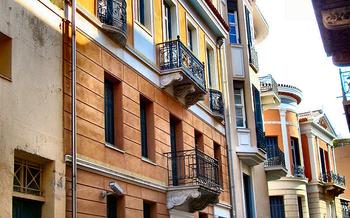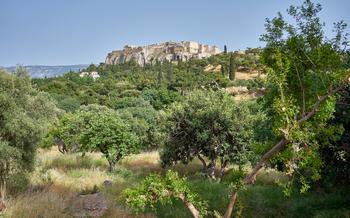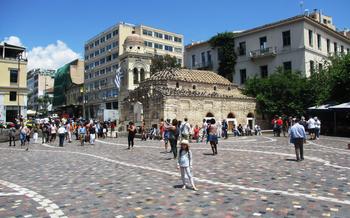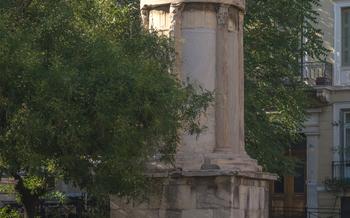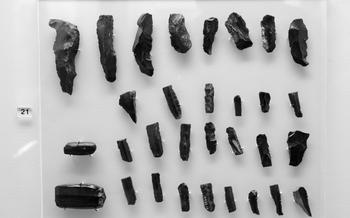
Museum of Greek Folk Art
- Historical Background
- Location and Accessibility
- Exhibition Highlights
- Traditional Costumes
- Textiles and Weaving
- Woodworking and Carving
- Metalworking and Jewelry
- Pottery and Ceramics
- Basket Weaving and Straw Art
- Musical Instruments
- Educational Programs and Workshops
- Temporary Exhibitions
- Museum Shop
- Visitor Tips
- Insider Tip: Hidden Gem and Rooftop Surprise
Historical Background
The Museum of Greek Folk Art is a treasure trove of Greek culture and traditions, preserving the rich heritage of the Greek people through its collection of artifacts and exhibits. Established in 1955, the museum's mission is to promote and educate visitors about the diverse folk art forms that have shaped Greek society over the centuries.
Folk art in Greece is a reflection of the country's vibrant history, diverse ethnic groups, and rich cultural traditions. From the intricate embroidery of traditional costumes to the finely crafted ceramics and pottery, folk art showcases the creativity, craftsmanship, and resilience of the Greek people. By preserving and showcasing these treasures, the Museum of Greek Folk Art plays a vital role in ensuring that these traditions continue to thrive and inspire future generations.
Location and Accessibility
The Museum of Greek Folk Art is conveniently located in the heart of Athens, at 17 Kydathineon Street, Plaka. This vibrant neighborhood is known for its charming streets, traditional shops, and historical landmarks, making it a popular destination for both locals and tourists. The museum is within walking distance from major attractions such as the Acropolis, Ancient Agora, and Monastiraki Square, allowing visitors to easily combine a visit to the museum with other sightseeing activities. Public transportation options are abundant, with the nearest metro station, Thissio, just a short stroll away. For those arriving by car, limited street parking is available in the surrounding area.
Exhibition Highlights
The Museum of Greek Folk Art showcases a diverse collection of artifacts and exhibits that offer a glimpse into the rich cultural heritage of Greece. Among the highlights of the museum's collection are:
-
Intricate Wood Carvings: Marvel at the exquisite wood carvings that adorn furniture, chests, and everyday objects, showcasing the exceptional craftsmanship of Greek woodworkers.
-
Traditional Costumes: Explore the vibrant collection of traditional costumes from various regions of Greece, each adorned with unique embroidery and intricate designs that reflect regional identities and cultural practices.
-
Woven Textiles: Discover the artistry of Greek textiles, including intricately woven rugs, blankets, and clothing, which showcase the diversity of weaving techniques and the symbolic meanings associated with different patterns.
-
Metalwork and Jewelry: Admire the delicate jewelry pieces crafted using traditional techniques such as filigree and granulation, showcasing the skill and creativity of Greek metalworkers.
-
Pottery and Ceramics: Delve into the ancient art of Greek pottery, with a variety of vessels, plates, and decorative items that showcase diverse styles and techniques, from simple utilitarian forms to elaborately painted designs.
-
Basket Weaving: Witness the intricate craftsmanship of Greek basket weavers, who use natural materials like straw and reeds to create functional and decorative baskets, mats, and other items that reflect the rural traditions of the country.
-
Musical Instruments: Explore the diverse collection of traditional Greek musical instruments, including the bouzouki, lyre, and santouri, each with its unique sound and role in Greek music and festivities.
These are just a few of the many treasures that await visitors at the Museum of Greek Folk Art, offering a comprehensive journey through the rich cultural heritage of Greece.
Traditional Costumes
The Museum of Greek Folk Art houses a stunning collection of traditional costumes from various regions of Greece, providing a glimpse into the rich cultural heritage and diverse identities of the country. Each costume, meticulously crafted and adorned with intricate embroidery and embellishments, represents a region's distinct traditions, customs, and lifestyle.
The Cretan costumes, for instance, stand out with their vibrant colors, intricate embroidery, and elaborate headwear, reflecting the island's strong sense of cultural identity. In contrast, the Pontic costumes, originating from the Black Sea region, feature unique woven fabrics and distinctive motifs that showcase the cultural influences of the region's diverse ethnic groups.
The Epirus region's costumes are known for their intricate embroidery and the use of metallic threads, creating a dazzling display of craftsmanship. Meanwhile, the costumes from the Cycladic islands are characterized by their simplicity and elegance, with flowing white garments and colorful woven accents.
These traditional costumes, with their rich symbolism and historical significance, offer a fascinating journey through the diverse cultural landscape of Greece, highlighting the country's deep-rooted connection to its folk heritage.
Textiles and Weaving
Textiles played a crucial role in Greek folk art, with weaving and embroidery being among the most prominent crafts. Greek weavers employed various techniques, including loom weaving, backstrap weaving, and sprang, to create a diverse range of textiles. Wool, cotton, and silk were the primary materials used, often sourced from local flocks and cultivated crops.
Embroidery was a highly regarded art form, with intricate patterns and motifs adorning traditional costumes, household linens, and decorative items. The most common stitches included cross-stitch, satin stitch, and counted thread embroidery. Each region of Greece had its own distinct embroidery style, reflecting local traditions and influences.
Woven goods and embroidery held both practical and symbolic significance in Greek culture. Rugs and blankets were essential for warmth and comfort in rural households, while elaborately embroidered textiles were often used for special occasions such as weddings, baptisms, and religious festivals. The colors, patterns, and motifs used in these textiles often carried symbolic meanings, representing fertility, protection, and good luck.
One of the highlights of the museum's collection is a stunningly preserved 19th-century bridal costume from the Peloponnese region. The costume features a long, flowing gown adorned with intricate embroidery that depicts scenes from Greek mythology. The vibrant colors and detailed craftsmanship of this garment exemplify the skill and artistry of Greek folk weavers and embroiderers.
Woodworking and Carving
Greek woodworking, with its intricate carvings and exquisite furniture, represents a profound chapter in the country's folk art heritage. Skilled artisans employed wood in crafting everyday objects that were both functional and aesthetically pleasing. Chests, adorned with intricate carvings depicting mythological scenes or floral motifs, served as valuable storage pieces in homes. Spoons, with their carefully carved handles, added a touch of artistry to the simplest of meals. Musical instruments, such as the lyre and the santouri, showcased the exceptional craftsmanship and attention to detail of Greek woodworkers. These instruments, meticulously carved and assembled, produced enchanting melodies that filled village squares and festive gatherings.
Woodworking techniques varied depending on the region and the purpose of the object being created. Carving, a prominent technique, involved using chisels and gouges to create intricate designs on wood surfaces. Joiners employed mortise and tenon joints to assemble furniture pieces, ensuring both durability and aesthetic appeal. The use of wood extended beyond furniture and musical instruments, encompassing a wide range of objects such as decorative panels, religious icons, and even toys. Each piece bore witness to the skill and artistry of Greek woodworkers, who transformed ordinary wood into objects of beauty and utility.
Metalworking and Jewelry
Metalworking holds a significant place in Greek folk art, particularly in the realm of jewelry. Greek artisans have mastered the art of crafting intricate and exquisite pieces that showcase their exceptional skills and creativity. Gold, silver, and bronze are the primary metals used in traditional Greek jewelry, and each piece is meticulously handcrafted using techniques passed down through generations.
Filigree, a delicate technique involving the intricate weaving of fine metal threads, is a hallmark of Greek metalworking. Artisans use this technique to create delicate and airy pieces that resemble lace. Granulation, another intricate technique, involves fusing tiny metal beads onto a base metal to create intricate patterns and designs.
Traditional Greek jewelry often features intricate and symbolic motifs, drawing inspiration from nature, mythology, and religious iconography. Necklaces, earrings, bracelets, and rings are adorned with intricate filigree work, granulation, and gemstones, showcasing the skill and artistry of Greek jewelers.
One of the most iconic pieces of traditional Greek jewelry is the "mati" or "evil eye" pendant. This amulet is believed to protect the wearer from bad luck and negative energy. It is often crafted in gold or silver and features a concentric circle design with a central blue bead representing the evil eye.
Pottery and Ceramics
The Museum of Greek Folk Art houses an impressive collection of pottery and ceramics, showcasing the diverse styles and techniques that have flourished in Greece throughout history. From ancient cooking vessels to decorative plates and vases, these ceramic artifacts provide a glimpse into the everyday lives and artistic traditions of the Greek people.
One of the highlights of the collection is a selection of Neolithic pottery from the 7th millennium BC, demonstrating the early origins of ceramic craftsmanship in Greece. These simple, yet elegant vessels showcase the basic techniques of hand-building and firing that were used by early potters.
In contrast, the museum also displays a range of elaborate Byzantine ceramics from the 12th and 13th centuries. These pieces are characterized by their intricate designs, often featuring religious motifs or scenes from everyday life. The use of glazes and multicolor decoration adds to the beauty and sophistication of these Byzantine ceramics.
The collection also includes a variety of traditional pottery from different regions of Greece, each with its own unique style and characteristics. For example, the island of Crete is known for its distinctive pottery with geometric patterns and vibrant colors, while the Peloponnese region is famous for its black-glazed ceramics.
Visitors to the Museum of Greek Folk Art can learn about the different techniques used by Greek potters, such as wheel throwing, hand-building, and glazing. The museum also provides insights into the symbolic meanings associated with various pottery designs and motifs, which often reflect cultural beliefs and traditions.
Whether you are a history buff, an art enthusiast, or simply curious about Greek culture, the Museum of Greek Folk Art's collection of pottery and ceramics is a must-see. These beautiful and fascinating artifacts offer a glimpse into the rich history and diverse artistic traditions of Greece.
Basket Weaving and Straw Art
The Museum of Greek Folk Art showcases the intricate art of basket weaving, a traditional craft that has played an important role in Greek rural communities for centuries. Using natural materials like straw and reeds, skilled artisans create a variety of functional and decorative objects, including baskets, mats, and decorative items.
The museum's collection features a diverse range of baskets, each demonstrating unique techniques and styles. From simple, rustic baskets used for everyday tasks to elaborate, intricately woven pieces adorned with colorful patterns, these artworks provide a glimpse into the creativity and craftsmanship of Greek folk artists.
Visitors can learn about the different techniques used in basket weaving, such as coiling, twining, and plaiting, and appreciate the intricate designs and patterns that adorn these traditional objects. The museum also highlights the cultural significance of basket weaving in Greek rural communities, where it has been an important source of income and a way to preserve traditional skills and knowledge.
Musical Instruments
The Museum of Greek Folk Art houses an impressive collection of traditional Greek musical instruments, offering visitors a glimpse into the rich musical heritage of the country. From the haunting melodies of the bouzouki to the lively rhythms of the lyre and the santouri, each instrument tells a story of cultural expression and artistic craftsmanship.
The bouzouki, a long-necked stringed instrument, is perhaps the most iconic Greek instrument. Its distinctive sound has captivated audiences around the world and is often associated with traditional Greek music. Visitors can admire the intricate craftsmanship of the bouzouki, with its beautiful inlaid designs and polished wood.
Another notable instrument is the lyre, a stringed instrument with a history dating back to ancient Greece. The lyre's gentle, melodic sound has been immortalized in Greek mythology and literature. The museum's collection includes lyres of various sizes and shapes, each one showcasing the skill and artistry of traditional craftsmen.
The santouri, a trapezoidal hammered dulcimer, is a unique instrument that produces a mesmerizing, ethereal sound. Its metal strings are struck with small hammers, creating a captivating melody that has enchanted listeners for centuries.
These are just a few examples of the diverse collection of musical instruments on display at the Museum of Greek Folk Art. Visitors can explore the museum's exhibits to discover the fascinating world of Greek folk music and appreciate the artistry and craftsmanship that have shaped this vibrant cultural tradition.
Educational Programs and Workshops
The Museum of Greek Folk Art offers a range of educational programs and workshops designed to engage visitors of all ages with the rich traditions of Greek folk heritage. These programs provide hands-on experiences that allow visitors to immerse themselves in the techniques and practices of traditional crafts.
One popular workshop is the pottery class, where participants can learn the basics of clay molding and glazing, creating their own unique ceramic pieces. Weaving workshops introduce visitors to the art of basket weaving, using natural materials like straw and reeds to create decorative baskets and mats.
For those interested in textiles, embroidery workshops offer the opportunity to learn traditional stitches and patterns, creating beautiful embroidered pieces that showcase the intricate craftsmanship of Greek folk art.
These educational programs are led by experienced craftspeople who share their knowledge and expertise with participants, providing insights into the cultural significance of traditional crafts and their role in Greek society.
Whether you're a seasoned artist or a complete beginner, these hands-on workshops offer a fun and interactive way to learn about and experience the vibrant traditions of Greek folk art.
Temporary Exhibitions
The Museum of Greek Folk Art hosts a dynamic program of temporary exhibitions that delve into specific aspects of Greek folk art or culture. These exhibitions offer visitors the opportunity to explore unique themes and gain deeper insights into the richness and diversity of Greek traditions. Past exhibitions have showcased topics such as the art of shadow theater, traditional textiles from the islands, and the role of music in Greek folklore.
Currently, the museum is presenting an exhibition titled "The Woven Odyssey: Traditional Greek Textiles in Motion." This exhibition showcases a stunning collection of woven goods from various regions of Greece, highlighting the intricate patterns, vibrant colors, and diverse techniques used by Greek weavers. Visitors can admire intricate rugs, blankets, and clothing adorned with traditional motifs, each telling a story of cultural heritage and craftsmanship.
Upcoming exhibitions include "The Sounds of Tradition: Greek Musical Instruments" and "The Art of Filigree: Delicate Jewels from Greece." These exhibitions will explore the rich world of Greek musical heritage and the exquisite craftsmanship of traditional Greek jewelry. Visitors can expect to see a variety of instruments, from the soulful sounds of the bouzouki to the melodic tones of the santouri, as well as intricate jewelry pieces that showcase the skill and artistry of Greek metalworkers.
For the most up-to-date information on current and upcoming temporary exhibitions, visitors are encouraged to check the museum's website or follow its social media channels. These exhibitions offer a unique opportunity to delve deeper into the fascinating world of Greek folk art and gain a greater appreciation for the country's rich cultural heritage.
Museum Shop
The Museum of Greek Folk Art houses a well-stocked museum shop where visitors can find a treasure trove of souvenirs to take home. From intricately painted ceramics to colorful woven textiles, and from delicate filigree jewelry to traditional musical instruments, the shop offers a wide variety of handcrafted items inspired by Greek folk art and culture.
The museum shop is a great place to find unique gifts for friends and family, or to treat yourself to a special souvenir of your visit to Greece. All proceeds from the shop go directly to supporting the museum's educational programs and exhibitions, so you can feel good about your purchase knowing that you are contributing to the preservation and promotion of Greek folk heritage.
Visitor Tips
-
For the best experience, plan your visit during the off-season (September to May) to avoid crowds and enjoy a more intimate museum experience.
-
Allow at least two to three hours to explore the museum's extensive collection and exhibits thoroughly.
-
Photography is permitted inside the museum, but using flash or tripods is prohibited to preserve the artifacts.
-
Combine your visit to the Museum of Greek Folk Art with other nearby attractions, such as the National Archaeological Museum or the Acropolis, to immerse yourself in Greece's rich history and culture.
-
The museum is wheelchair accessible, with ramps and elevators providing easy access to all floors.
Insider Tip: Hidden Gem and Rooftop Surprise
For a unique and breathtaking experience, venture to the museum's rooftop terrace. Often overlooked by visitors, this hidden gem offers panoramic views of the city, including the Acropolis and the surrounding hills. Take a moment to soak in the beauty of Athens from this privileged vantage point and capture some Insta-worthy shots. The rooftop terrace is the perfect spot to unwind after exploring the museum's exhibits and to gain a new perspective on the city's vibrant tapestry.

